Analysis of Observations near the Fourth Electron Gyrofrequency Heating Experiment in EISCAT
Abstract
1. Introduction
2. Experimental Setup
3. Observations
3.1. ISR Spectrum
3.2. Electron Temperature
3.3. Electron Density
4. Discussion
4.1. Plasma Line
4.2. Electron Temperature and Electron Density
5. Conclusions
Author Contributions
Funding
Data Availability Statement
Acknowledgments
Conflicts of Interest
References
- Gurevich, A.V. Nonlinear effects in the ionosphere. Phys. Usp. 2007, 50, 1091. [Google Scholar] [CrossRef]
- Frolov, V.L.; Bakhmet’eva, N.V.; Belikovich, V.V.; Vertogradov, G.G.; Vertogradov, V.G.; Komrakov, G.P.; Kotik, D.S.; Mityakov Nikolai, A.; Polyakov, S.V.; Rapoport, V.O. Modification of the earth’s ionosphere by high-power high-frequency radio waves. Phys. Usp. 2007, 50, 315–324. [Google Scholar] [CrossRef]
- Brodin, G.; Stenflo, L. A new decay channel for upper-hybrid waves. Phys. Scr. 2016, 91, 104005. [Google Scholar] [CrossRef]
- Mjølhus, E. On the small scale striation effect in ionospheric radio modification experiments near harmonics of the electron gyro frequency. J. Atmos. Terr. Phys. 1993, 55, 907–918. [Google Scholar] [CrossRef]
- Honary, F.; Stocker, A.J.; Robinson, T.R.; Jones, T.B.; Stubbe, P. Ionospheric plasma response to HF radio waves operating at frequencies close to the third harmonic of the electron gyrofrequency. J. Geophys. Res. Space Phys. 1995, 100, 21489–21501. [Google Scholar] [CrossRef]
- Robinson, T.R.; Honary, F.; Stocker, A.J.; Jones, T.B.; Stubbe, P. First EISCAT observations of the modification of F-region electron temperature during RF heating at harmonics of the electron gyro-frequency. J. Atmos. Terr. Phys. 1996, 58, 385–395. [Google Scholar] [CrossRef]
- Borisova, T.D.; Blagoveshchenskaya, N.F.; Kalishin, A.S.; Kosch, M.; Senior, A.; Rietveld, M.T.; Yeoman, T.K.; Hagstrom, I. Phenomena in the high-latitude ionospheric F region induced by a HF heater wave at frequencies near the fourth electron gyroharmonic. Radiophys. Quantum Electron. 2014, 57, 1–19. [Google Scholar] [CrossRef]
- Pedersen, T.; Gustavsson, B.; Mishin, E.; Kendall, E.; Mills, T.; Carlson, H.C.; Snyder, A.L. Creation of artificial ionospheric layers using high-power HF waves. Geophys. Res. Lett. 2010, 37, 211–228. [Google Scholar] [CrossRef]
- Sergeev, E.; Grach, S.; Shindin, A.; Mishin, E.; Bernhardt, P.; Briczinski, S.; Isham, B.; Broughton, M.; Labelle, J.; Watkins, B. Artificial Ionospheric Layers during Pump Frequency Stepping Near the 4th Gyroharmonic at HAARP. Phys. Rev. Lett. 2013, 110, 065002. [Google Scholar] [CrossRef] [PubMed]
- Dhillon, R.S.; Robinson, T.R. Observations of time dependence and aspect sensitivity of regions of enhanced UHF backscatter associated with RF heating. Ann. Geophys. 2005, 23, 75–85. [Google Scholar] [CrossRef]
- Ashrafi, M.; Kosch, M.J.; Kaila, K.; Isham, B. Spatiotemporal evolution of radio wave pump-induced ionospheric phenomena near the fourth electron gyroharmonic. J. Geophys. Res. Space Phys. 2007, 112, 05314. [Google Scholar] [CrossRef]
- Mishin, E.; Watkins, B.; Lehtinen, N.; Eliasson, B.; Pedersen, T.; Grach, S. Artificial ionospheric layers driven by high-frequency radio waves: An assessment. J. Geophys. Res. Space Phys. 2016, 121, 3497–3524. [Google Scholar] [CrossRef]
- Kuo, S.P. Electron cyclotron harmonic resonances in high-frequency heating of the ionosphere. Phys. Plasma 2013, 20, 092124. [Google Scholar] [CrossRef]
- Borisova, T.D.; Blagoveshchenskaya, N.F.; Kalishin, A.S.; Rietveld, M.T.; Yeoman, T.K.; Hägström, I. Modification of the high-latitude ionospheric F region by high-power HF radio waves at frequencies near the fifth and sixth electron gyroharmonics. Radiophys. Quantum Electron. 2016, 58, 561–585. [Google Scholar] [CrossRef]
- Wu, J.; Wu, J.; Rietveld, M.T.; Haggstrom, I.; Zhao, H.; Xu, Z. The behavior of electron density and temperature during ionospheric heating near the fifth electron gyrofrequency. J. Geophys. Res. Space Phys. 2017, 122, 1277–1295. [Google Scholar] [CrossRef]
- Lehtinen, M.S.; Huuskonen, A. General incoherent scatter analysis and GUISDAP. J. Atmos. Terr. Phys. 1996, 58, 435–452. [Google Scholar] [CrossRef]
- Stubbe, P.; Kohl, H.; Rietveld, M.T. Langmuir turbulence and ionospheric modification. J. Geophys. Res. Space Phys. 1992, 97, 6285–6297. [Google Scholar] [CrossRef]
- Kohl, H.; Kopka, H.; Stubbe, P.; Rietveld, M.T. Introduction to ionospheric heating experiments at Tromsø-II. Scientific problems. J. Atmos. Terr. Phys. 1993, 55, 601–613. [Google Scholar] [CrossRef]
- Pedersen, T.; Gustavsson, B.; Mishin, E. Optical ring formation and ionization production in high-power HF heating experiments at HAARP. Geophys. Res. Lett. 2009, 36, L18107. [Google Scholar] [CrossRef]
- Pedersen, T.; Gustavsson, B.; Mishin, E. Production of artificial ionospheric layers by frequency sweeping near the 2nd gyroharmonic. Ann. Geophys. 2011, 29, 47–51. [Google Scholar] [CrossRef]
- Hysell, D.L.; Miceli, R.J.; Kendall, E.A.; Schlatter, N.M.; Varney, R.H.; Watkins, B.J.; Pedersen, T.R.; Bernhardt, P.A.; Huba, J.D. Heater-induced ionization inferred from spectrometric airglow measurements. J. Geophys. Res. Space Phys. 2014, 119, 2038–2045. [Google Scholar] [CrossRef]
- Borisova, T.D.; Blagoveshchenskaya, N.F.; Rietveld, M.T.; Häggström, I. Outshifted Plasma Lines Observed in Heating Experiments in the High-Latitude Ionosphere at Pump Frequencies Near Electron Gyroharmonics. Radiophys. Quantum Electron. 2019, 61, 722–740. [Google Scholar] [CrossRef]
- Dubois, D.F.; Rose, H.; Russell, D. Power spectra of fluctuations in strong Langmuir turbulence. Phys. Rev. Lett. 1988, 61, 2209–2212. [Google Scholar] [CrossRef] [PubMed]
- Kuo, S.P.; Lee, M.C. A source mechanism producing HF-induced plasma lines (HFPLS) with up-shifted frequencies. Geophys. Res. Lett. 1992, 19, 249–252. [Google Scholar] [CrossRef]
- Kuo, S.P.; Lee, M.C. On the generation of a broad downshifted spectrum of HF wave enhanced plasma lines in the ionospheric heating experiments. Geophys. Res. Lett. 1999, 26, 3289–3292. [Google Scholar] [CrossRef]
- Najmi, A.; Eliasson, B.; Shao, X.; Milikh, G.M.; Papadopoulos, K. Simulations of ionospheric turbulence produced by HF heating near the upper hybrid layer. Radio Sci. 2016, 51, 704–717. [Google Scholar] [CrossRef]
- Kuo, S.P. Cascade of the parametric decay instability in ionospheric heating experiments. J. Geophys. Res. Space Phys. 2001, 106, 5593–5597. [Google Scholar] [CrossRef]
- Dubois, D.F.; Rose, H.; Russell, D. Excitation of strong Langmuir turbulence in plasmas near critical density: Application to HF heating of the ionosphere. J. Geophys. Res. Space Phys. 1990, 95, 21221–21272. [Google Scholar] [CrossRef]
- Dubois, D.F.; Rose, H.; Russell, D. Coexistence of parametric decay cascades and caviton collapse at subcritical densities. Phys. Rev. Lett. 1991, 66, 1970–1973. [Google Scholar] [CrossRef]
- Dubois, D.F.; Hanssen, F.; Rose, H. Space and time distribution of HF excited Langmuir turbulence in the ionosphere: Comparison of theory and experiment. J. Geophys. Res. Space Phys. 1993, 98, 17543–17567. [Google Scholar] [CrossRef]
- Mishin, E.; Burke, W.; Pedersen, T. On the onset of HF-induced airglow at HAARP. J. Geophys. Res. Space Phys. 2004, 109, A02305. [Google Scholar] [CrossRef]
- Kuo, S.; Lee, M.; Kossey, P. Excitation of oscillating two-stream instability by upper hybrid pump in ionospheric heating experiments at Tromsø. Geophys. Res. Lett. 1997, 24, 2969–2972. [Google Scholar] [CrossRef]
- Utlaut WF Violette, E.J. A summary of vertical incidence radio observations of ionospheric modification. Radio Sci. 1974, 9, 895–903. [Google Scholar] [CrossRef]
- Gurevich, A.V.; Lukyanov, A.V.; Zybin, K.P. Anomalous absorption of powerful radio waves on the striations developed during ionospheric modification. Phys. Lett. A 1996, 211, 363–372. [Google Scholar] [CrossRef]
- Mantas, G.P.; Carlson, H.C.; LaHoz, C.H. Thermal response of the F region ionosphere in artificial modification experiments by HF radio waves. J. Geophys. Res. Space Phys. 1981, 86, 561–574. [Google Scholar]
- Stocker, A.J.; Honary, F.; Robinson, T.R.; Jones, T.B.; Stubbe, P.; Kopka, H. EISCAT observations of large-scale electron temperture and electron density perturbations caused by high power HF radio waves. J. Atmos. Terr. Phys. 1992, 54, 1555. [Google Scholar] [CrossRef]
- Dysthe, K.B.; Mjølhus, E.; Pécseli, H. Thermal cavitons. Phys. Scr. 1982, 1982, 548. [Google Scholar] [CrossRef]
- Rietveld, M.T.; Kosch, M.J.; Blagoveshchenskaya, N.F.; Kornienko, V.A.; Leyser, T.B.; Yeoman, T.K. Ionospheric electron heating, optical emissions, and striations induced by powerful HF radio waves at high latitudes: Aspect angle dependence. J. Geophys. Res. Space Phys. 2003, 108, 1141–1156. [Google Scholar] [CrossRef]
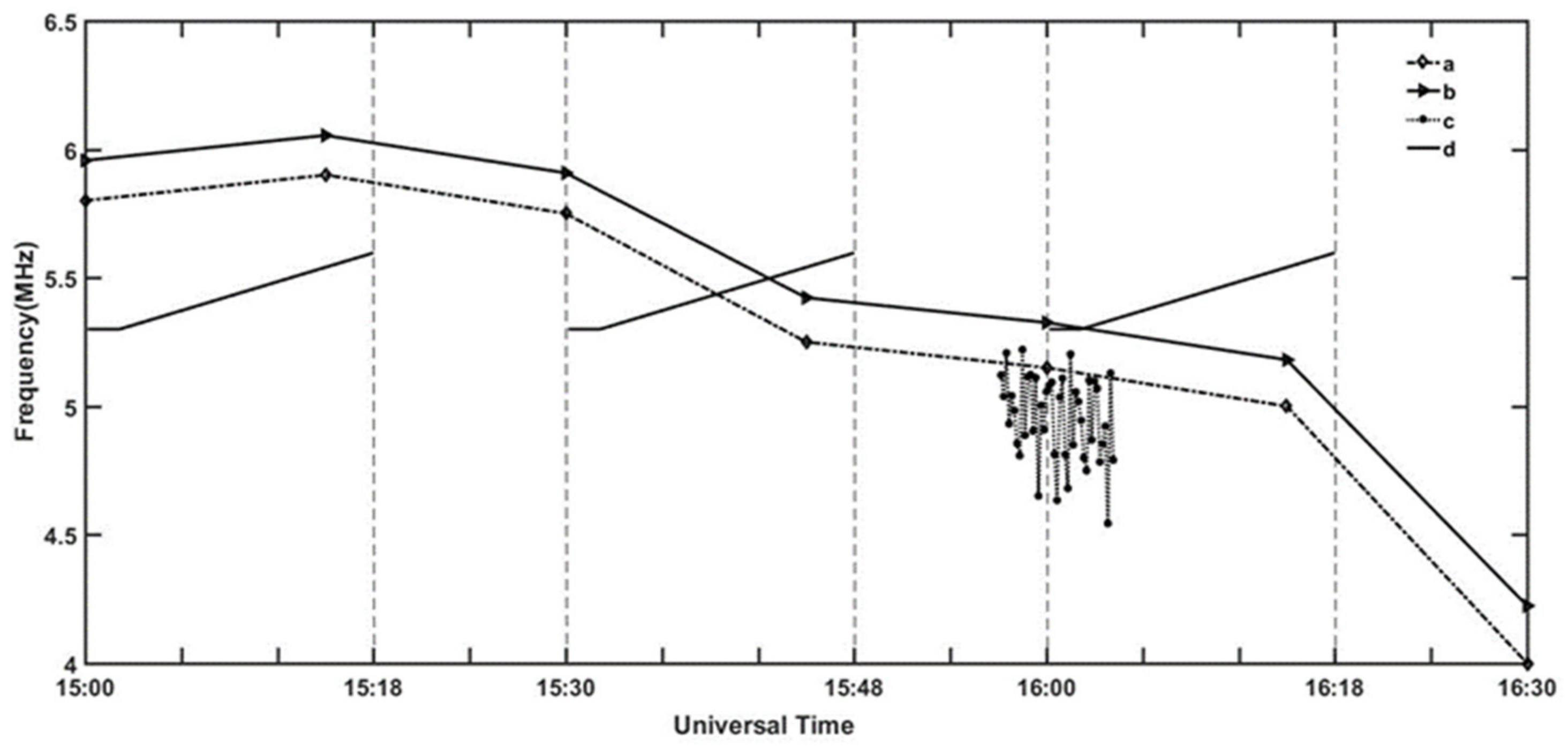
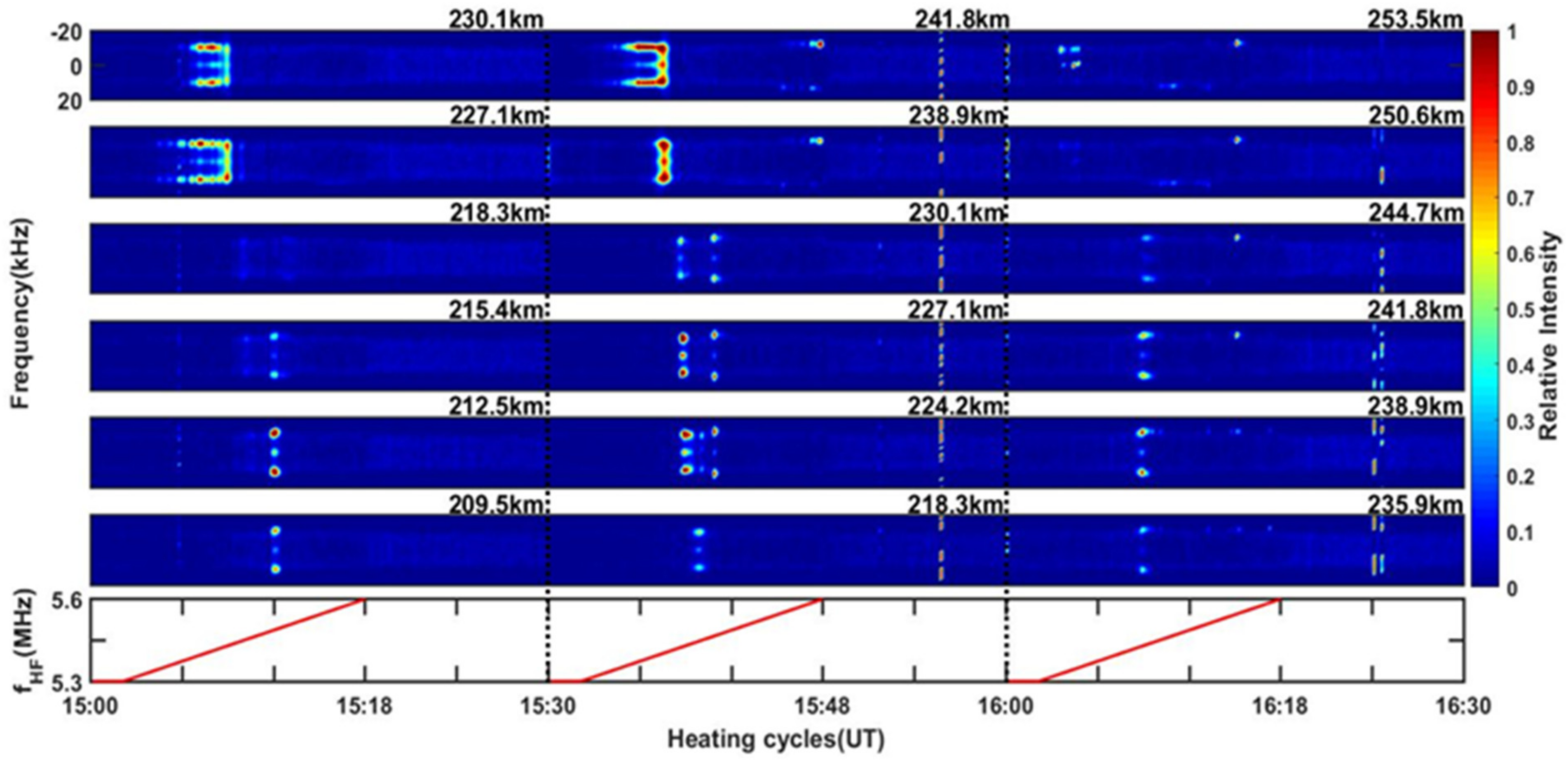
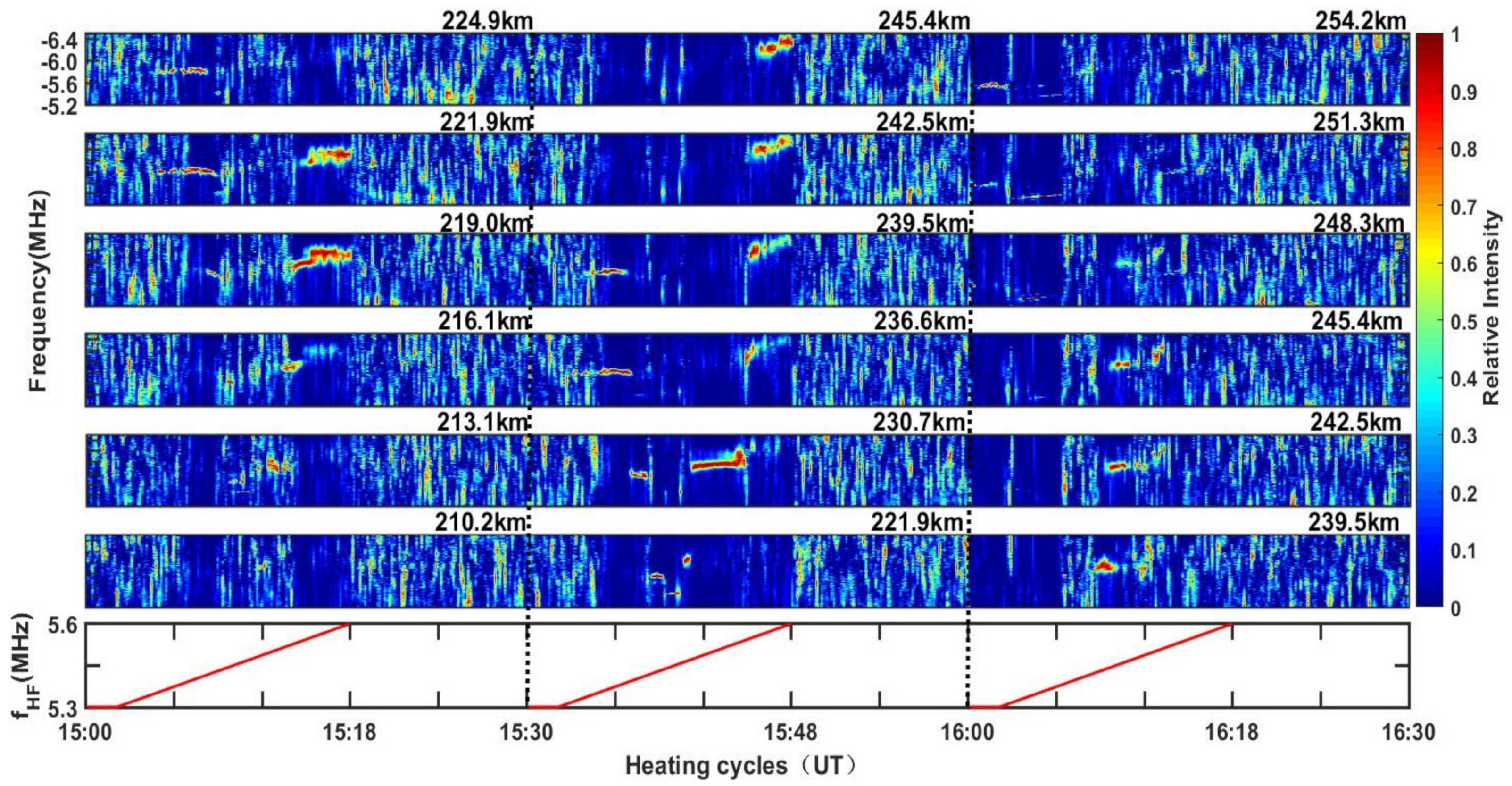
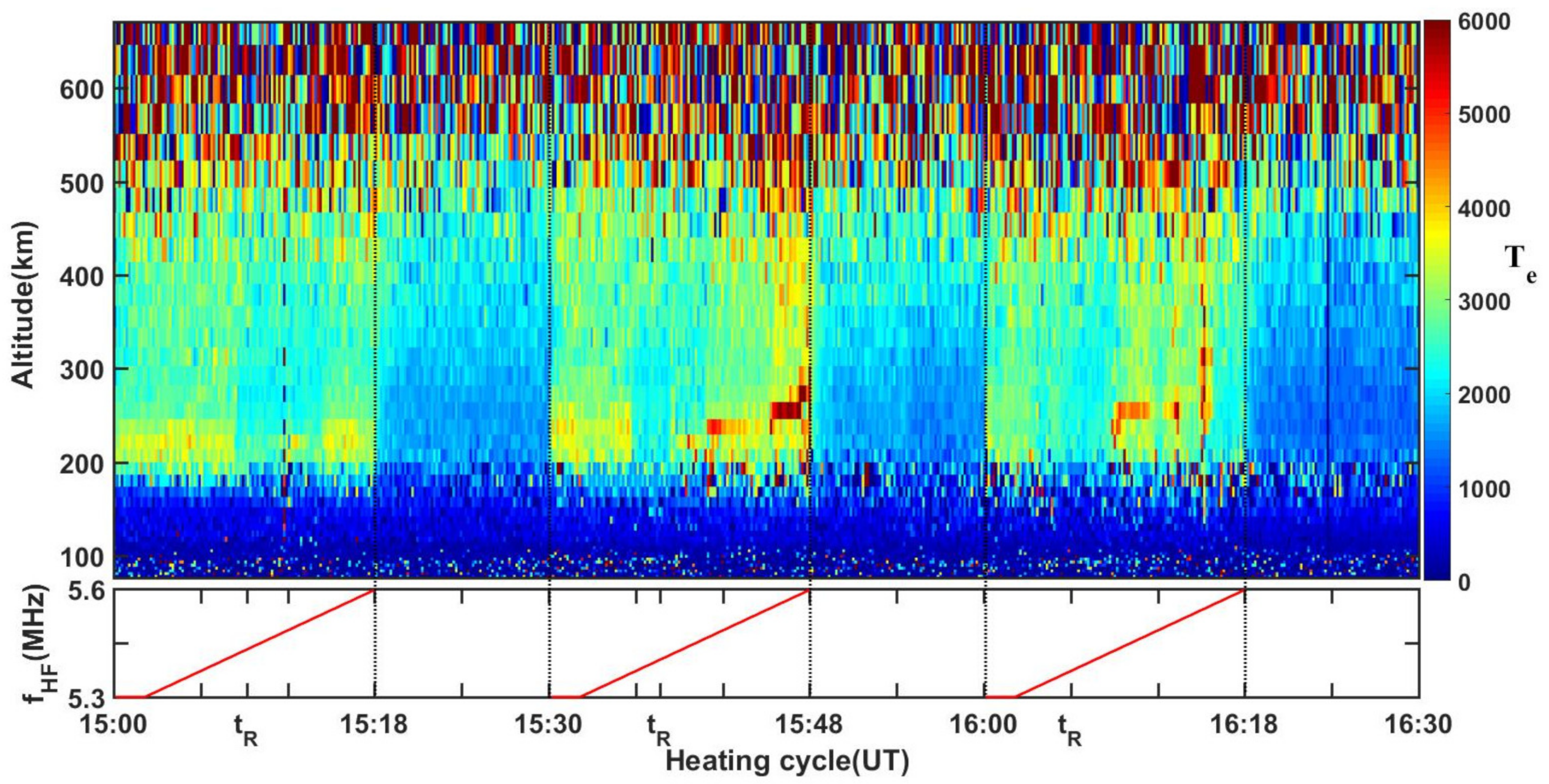
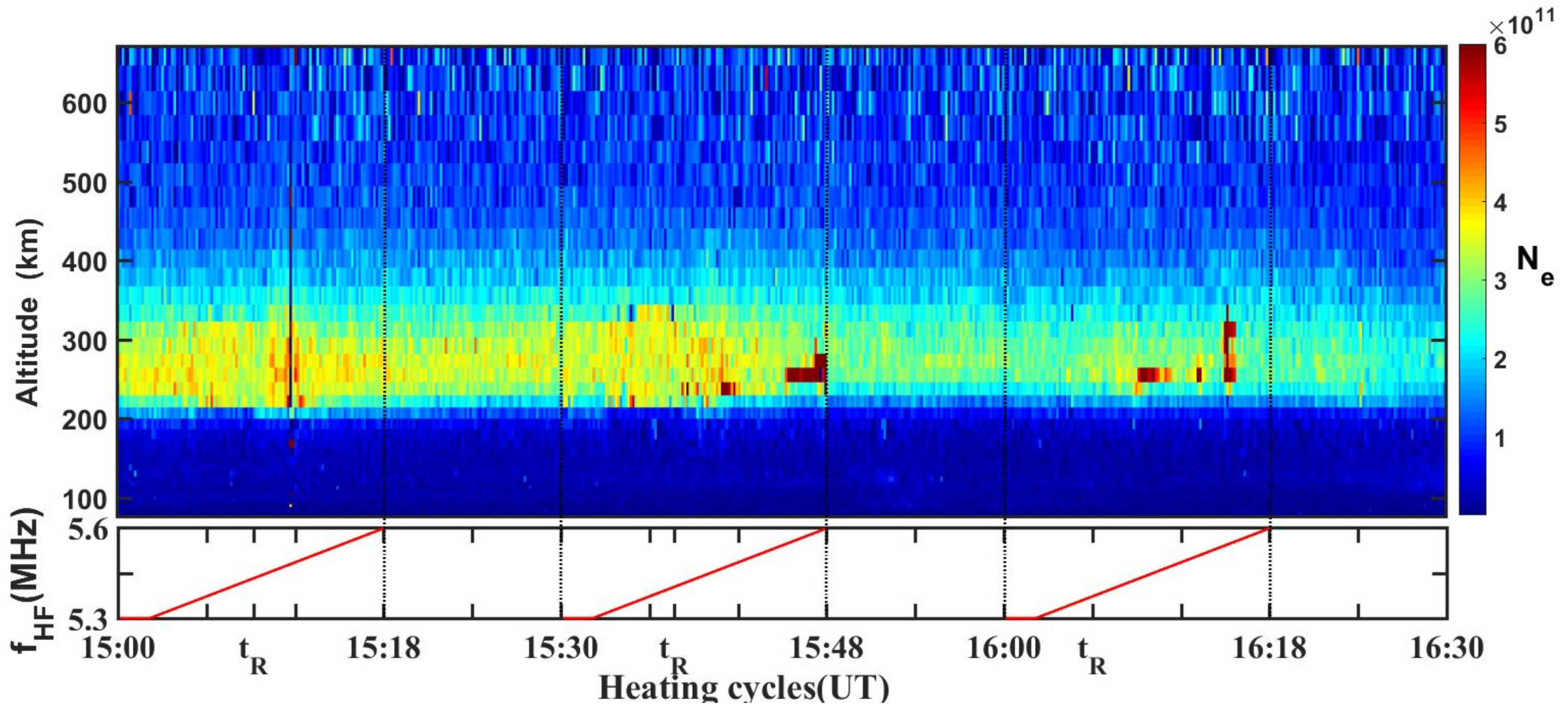
Publisher’s Note: MDPI stays neutral with regard to jurisdictional claims in published maps and institutional affiliations. |
© 2021 by the authors. Licensee MDPI, Basel, Switzerland. This article is an open access article distributed under the terms and conditions of the Creative Commons Attribution (CC BY) license (https://creativecommons.org/licenses/by/4.0/).
Share and Cite
Li, Z.; Fang, H.; Gong, H.; Guo, Z. Analysis of Observations near the Fourth Electron Gyrofrequency Heating Experiment in EISCAT. Universe 2021, 7, 191. https://doi.org/10.3390/universe7060191
Li Z, Fang H, Gong H, Guo Z. Analysis of Observations near the Fourth Electron Gyrofrequency Heating Experiment in EISCAT. Universe. 2021; 7(6):191. https://doi.org/10.3390/universe7060191
Chicago/Turabian StyleLi, Zeyun, Hanxian Fang, Hongwei Gong, and Zhe Guo. 2021. "Analysis of Observations near the Fourth Electron Gyrofrequency Heating Experiment in EISCAT" Universe 7, no. 6: 191. https://doi.org/10.3390/universe7060191
APA StyleLi, Z., Fang, H., Gong, H., & Guo, Z. (2021). Analysis of Observations near the Fourth Electron Gyrofrequency Heating Experiment in EISCAT. Universe, 7(6), 191. https://doi.org/10.3390/universe7060191





